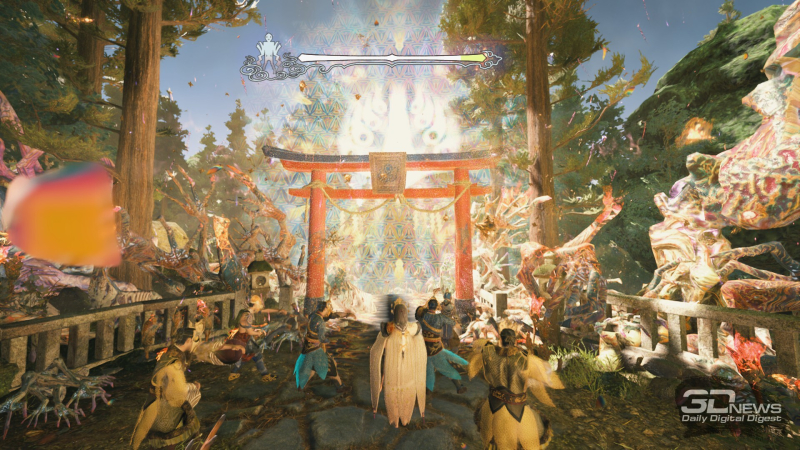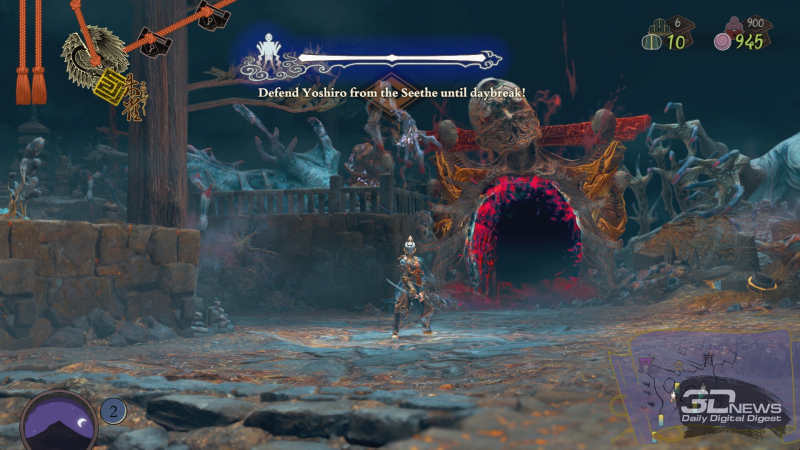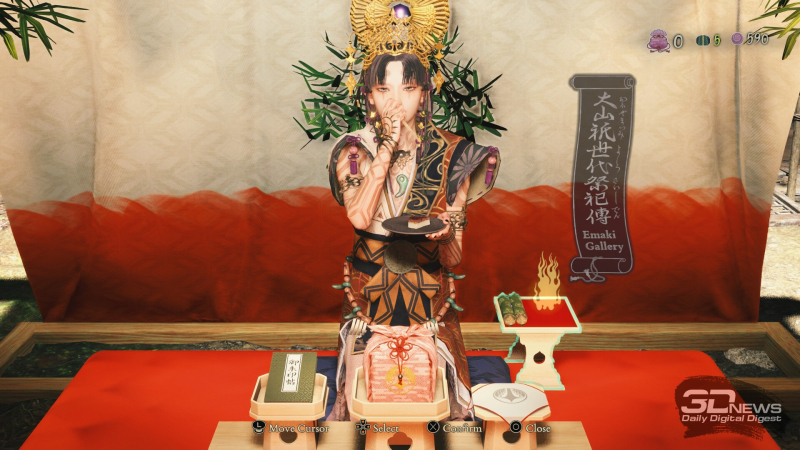Played on PC
The last six or seven years can safely be called another “golden era” for Capcom. The company is steadily releasing one big successful project after another and seems to not want to stop at all. It’s all the more interesting that between the next Monster Hunter, Street Fighter and Resident Evil, a unique project of a smaller scale has been squeezed in. From the first frames of the Kunitsu-Gami announcement, it seemed that the Japanese suddenly decided to return to the Onimusha series, but everything turned out to be much more interesting. The fresh creation really looks like an alien from the PS2 era, where pure gameplay ruled the roost, and only a couple of lines were devoted to the plot. And this approach still works great.

The ritual of purification is completed
⇡#I wish I could hold out until the morning
The storytelling here is really sparse. Demons suddenly appeared on Mount Kafuku, and we, in the role of a mysterious masked warrior, need to accompany the priestess Yoshiro, who, with the help of kagura, a ritual dance, cleanses the area of filth. The characters don’t speak, there aren’t really any cutscenes other than introducing the youkai. Everything is conveyed through the visuals and the gameplay itself, which is a bit like Fumito Ueda’s projects. True, only a little – Kunitsu-Gami lacks that special emotional connection that arose between the hero and his companion as the ICO progressed. Here the girl is perceived as another mechanic, and not a character you want to worry about.
However, this can hardly be called a flaw, because Path of the Goddess is clearly not about the plot. The gameplay is what makes Kunitsu-Gami one of the most interesting projects this year. The basics are simple: bring the priestess to the gate from which the monsters emerge and perform a cleansing ritual. True, it has a peculiarity – it’s an action game, but not pure, but with a tactical component and elements of tower defense.

Every night the gate opens, spewing out demons
Levels start early in the morning. While the sun is shining, you need to explore a small location, getting rid of the desecrated (if you remove them all, you get a useful amulet) and pulling out the local residents from their cocoons. Each of those released can be assigned a profession: an ordinary woodcutter or archer, or something more exotic like a gunner or a shaman. The further you progress, the more classes with their own leveling branch open up.
Planning begins already at the daytime stage. Special crystals are spent on assigning/changing professions and paving the way for the priestess, so you are constantly balancing between ensuring that the squad is minimally combat-ready and that the girl does not stand still for too long. And when night falls, the demons begin to attack – and here everything depends on how you managed to prepare for it and what kind of squad you assembled. The main goal is to hold out until the next morning and prevent all sorts of freaks from killing Yoshiro.
On the one hand, it seems easy. The main character is strong in his own right, and the game as a whole is not difficult. On the other hand, in the light of the sun, Yoshiro moves around the map, albeit along a predetermined route. And here you need to understand whether you want to get as far as possible, ending up at sunset in an open area where it will be difficult to defend, or is it better to stay in a more advantageous position, but then spend an extra night, or even two, fighting? Whatever you choose, the defense will be interesting in any case thanks to the different combinations of enemies.

The girl doesn’t have time to get there a little. Well it’s going to be a hot night
After playing the demo, I had some concerns that there wouldn’t be enough variety on release. Fortunately, Kunitsu-Gami constantly changes the conditions and approach to battles. Somewhere the terrain itself will pose a danger, somewhere you won’t be allowed to fight personally, but only to command your wards, somewhere a huge enemy will suddenly appear or there will be no assistants at all. There are enough variations so that the game does not get boring during the 9-10 hours that the campaign lasts. In addition, numerous bosses also add to the fun, forcing you to reconsider the usual composition of your squad, especially if you aim to kill them within a certain time. And the second half of the “plot” entertains with a large number of demons and attacks from all sides – so that the bloody night feels like it lasts a very, very long time.
Clearing the land is not the only thing that needs to be done here. Between stages, you can take a short breath in the liberated settlements to pleasant music, soft keyboards reminiscent of the compositions of Daisuke Kashiwa. Treat Yoshiro with sweets, upgrade both your character and the professions of the freed residents, and at the same time gradually put the villages in order. For this they provide useful resources for obtaining new abilities and other rewards. And it’s simply aesthetically pleasing to see how just yesterday a gloomy, ruined village, overflowing with demons, is transformed literally before our eyes. This attention to detail makes the game world much more alive and allows you to become more attached to it.
However, one of the main advantages for me personally is that Kunitsu-Gami does not try to be everything at once, which is the fault of many modern games. There are no unnecessary mechanics or anything else that would distract from the main gameplay loop. Neither combat episodes nor the restoration of settlements take much time – all ideas are organically intertwined with each other, and hot battles and calm moments alternately replace each other at a controlled pace. This makes it quite difficult to tear yourself away from the game.

At the camp you can relax and try some delicious food. Moreover, each also has a detailed description, rooted in the history of Japan.
Although for a project where it is necessary not only to control the hero, but also to command AI fighters, there is a surprisingly inconvenient interface and a small number of features. In ordinary battles, they only allow you to indicate where this or that ward should stand, and who and how to beat, he will decide for himself. In battles with bosses, you can additionally order everyone to either attack the large demon or protect the priestess. This isn’t too much of a nuisance, but it often reduces management to simply huddling everyone around the girl rather than placing everyone one by one each evening. And in general, I would like to see more complex situations where tactical planning would help solve the problem.
However, minor inconveniences and relatively low difficulty are a small price to pay for the unusual and exciting adventure that Capcom offers. Kunitsu-Gami perfectly manages to convey the spirit of mystical medieval Japan, everything is good in terms of gameplay, and the excellent pace does not allow you to move away from the monitor. It’s nice to see that the company still wants to experiment and release small, unique projects that can surprise not only with the fact of their existence, but also with interesting ideas.
Advantages:
- An entertaining mixture of action and tower defense elements;
- A wide variety of bosses;
- There are no unnecessary mechanics in the game – everything is connected to each other, which helps create an exciting gameplay cycle;
- General mystical atmosphere.
Disadvantages:
- The tactical component turned out to be weak – residents only need to choose professions wisely, perhaps, only on bosses;
- Minor unpleasant bugs sometimes prevent you from fulfilling additional conditions at levels;
- The squad management interface looks beautiful, but is inconvenient and does not really perform its main functions.
Graphic arts
Visually, Kunitsu-Gami looks rather unremarkable, which, however, does not prevent it from sometimes producing a very colorful picture.
Sound
In the absence of dialogue, music becomes the main tool for conveying mood. Airy keyboard parts are juxtaposed with suddenly loud jazz kicks, and even silence is used to emphasize certain moments.
Single player game
The game attempted to combine several genres into one – and the attempt was successful. The tactical component turned out to be simple, which does not prevent you from creating many interesting combat situations, and you look forward to the next morning.
Estimated time of completion
9-10 hours for a normal passage without completing all the tests. Two or three times more if you set out to collect everything and run through “New Game +”.
Collective game
Not foreseen.
General impression
Kunitsu-Gami is another unique game in Capcom’s collection. It is very similar to the project of the PS2 era, which the company for some reason forgot to release then. One of the most unusual projects of this year, successfully combining several genres, a mysterious mystical atmosphere and entertaining gameplay.
Rating: 8.5 / 10
More about grading system